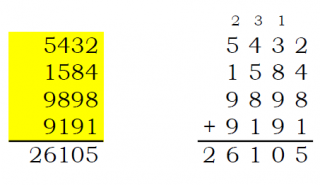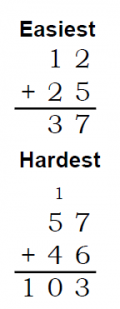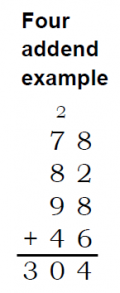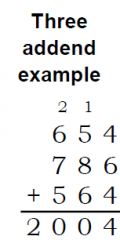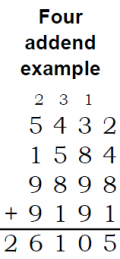Looking for long addition problems for worksheets, quizzes or tests for school kids learning multidigit or multi-addend addition? Can’t find a test that is just the right level for where your child is right now? Here is my own custom long addition test creator. It is an Excel spreadsheet, using formulas to generate random problems at a variety of different levels of difficulty you may need at any given time. You can print test after test, and they are never the same. Practice a different test every day or night if you want! To download, just click here.
Navigating the File
The Excel file has four tabs or worksheets along with an instruction tab, one for simple problems with two digit addends and only two addends, and one each for more complex two digit, three digit and four digit problems. On each tab or sheet, there are 63, 56, 48, or 40 problems, depending on complexity, that are randomly generated, with an answer key below. If you print the tab as set up in two pages, the first page is the test, and the second page is the answer key. You can skip the answer key by just printing page 1. If you are a teacher with a class of 30, you could print 30 copies of page one and one copy of page 2 for you. Maybe you are a student or home schooler who would like to have a test and then be able to check your work- print both pages and check your work after completing the test. The only way to get a printed answer key that matches the worksheet is to print them at the same time.
Printing the Test
The sheet is set for automatic recalculation, which means after every entry you make, the problems will all be dynamically changed per their formulas for random problems. You can turn off the automatic calculation by going to the formula tab portion of the Excel menu and making calculations manual. On most versions of Excel, you can manually calculate by pressing the “F9” key. I noticed that for my function keys to use the “F#” function, I have to hold down the “fn” button while I push the F9 key. You can also use the “Calculate Now” button from the “Formulas” tab- whatever you find easiest. Every time you press this key or re-calculate, all the problems and their answers will be changed to new problems. If you want three tests with different problems for three different nights, print one test, hit “F9”, print again, hit “F9”, and print again- you’ll get three different tests, all completely different, but the same level of difficulty.
Changing the Difficulty
If you’ve used some of my other math test from this website, there were options for adjusting difficulty. For this workbook, I decided that the best approach would be to just have different tabs with different levels of difficulty. By the time a student is doing long addition, there really isn’t much difference other than more digits or more addends to add together. So, each tab has different types of problems with increasing difficulty. There are no settings for changing the difficulty within a test, just the ability to recalculate and get new problems at the same difficulty.
Special Feature: Sample Solutions
I’ve added a new feature in this workbook that students might find a bit helpful- the sample solution on the right side of each sheet out of the printed area. There are yellow cells where a user can put in a value and the problem will be shown with an answer with work shown. So, for long addition, when adding a column and the sum is over 10, the person solving the problem would carry a one or maybe a bigger digit for longer lists of addends. This is shown in the solution. For addition, this may not be that big of a deal, but maybe a student may find it helpful in seeing how to solve a specific problem.
Specific Tab Information
All four tabs have essentially the same functionality, just different levels of problems. Let’s review the types of problems each tab includes.
Long Addition Tab
The Long Addition tab is the easiest tab. All problems are two addends, and each addend is two digits. There are 63 problems on the page. The problems do get more difficult as the page goes along. The first two rows have no problems that either digit adds up to over 9. This is done by limiting the digits to a max of 5 for the first addend and 4 for the second addend. The third and fourth rows gets a little more difficult with problems having bigger digits but none adding up to over nine. The rest of the sheet has the possibility of digits adding up to 10 or more, meaning a need to carry a one or having a total sum of over 100. The final row is set up to have every problem add up each digit to nine or higher, meaning virtually all sums will be over 100 and have to carry a one to the tens column.
Add 2 Digits Tab
The Add 2 digits tab includes more addends. Problems increase in difficulty from 2 addends up to 4 addends, but each addend is still two digits. There are 56 problems on the page. The problems do get more difficult as the page goes along. The first row has no problems that either digit adds up to over 9. This is done by limiting the digits to a max of 5 for the first addend and 4 for the second addend. The next three rows of the sheet have the possibility of digits adding up to 10 or more, meaning a need to carry a one or having a total sum of over 100. The fifth and sixth rows have three addends and can add up to over 200. The final two rows have four addends each and can add up to over 300.
Add 3 Digits Tab
The Add 3 digits tab is similar to 2 digits, but with three digit addends. Problems increase in difficulty from 2 addends up to 4 addends, but each addend has three digits. There are 48 problems on the page. The problems do get more difficult as the page goes along. The first row has no problems that each digit adds up to over 9. This is done by limiting the digits to a max of 5 for the first addend and 4 for the second addend. The next three rows of the sheet have the possibility of digits adding up to 10 or more, meaning a need to carry a one or having a total sum of over 1000. The fifth and sixth rows have three addends and can add up to over 2000. The final two rows have four addends each and can add up to over 3000.
Add 4 Digits Tab
The Add 4 digits tab is similar to 2 and 3 digit tabs, but with four digit addends. Problems increase in difficulty from 2 addends up to 4 addends, but each addend has four digits. There are 40 problems on the page. The problems do get more difficult as the page goes along. The first row has no problems that each digit adds up to over 9. This is done by limiting the digits to a max of 5 for the first addend and 4 for the second addend. The next three rows of the sheet have the possibility of digits adding up to 10 or more, meaning a need to carry a one or having a total sum of over 10,000. The fifth and sixth rows have three addends and can add up to over 20,000. The final two rows have four addends each and can add up to over 30,000.
Issues with the File?
Generally, if a user of the file avoids changing formulas in the sheets and follows the above instructions, the file should work fine. However, if you received this file from a source other than this original website and experience difficulties, try downloading a fresh free copy by clicking here. Depending on your browser and virus scanner, you may have to unblock or manually okay opening the file by adjusting file properties.
The website has other math worksheets available for free download, including dynamic 100 problem math facts for simple addition, subtraction, multiplication, and division. Similarly, there are fraction tests with addition, subtraction, multiplication, and division. I plan to offer other worksheets available for types of problems that math students often struggle with.
If you spot an error or have suggestions for improvement or other sheets, leave a comment on this page and I’ll look into it and make improvements if required.

